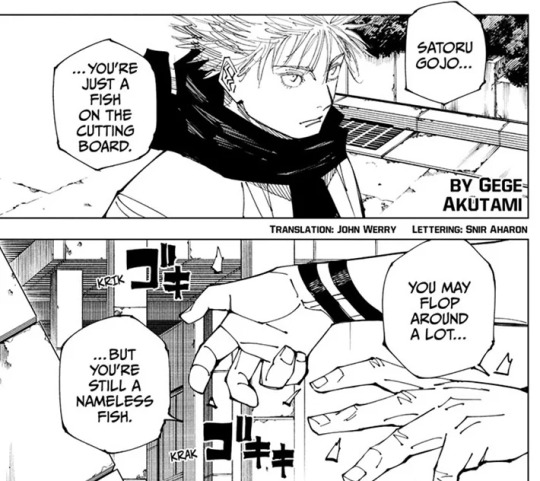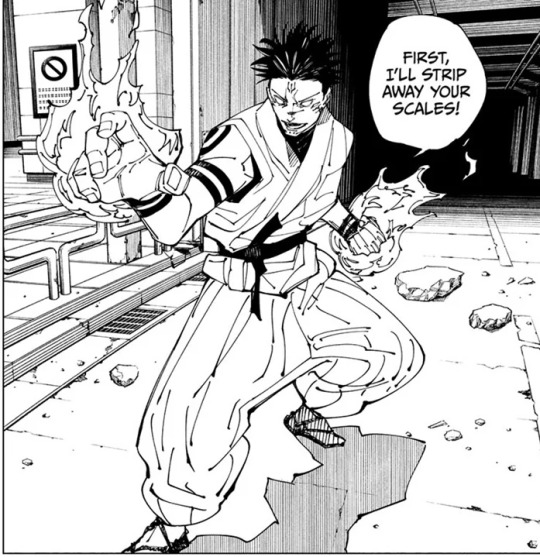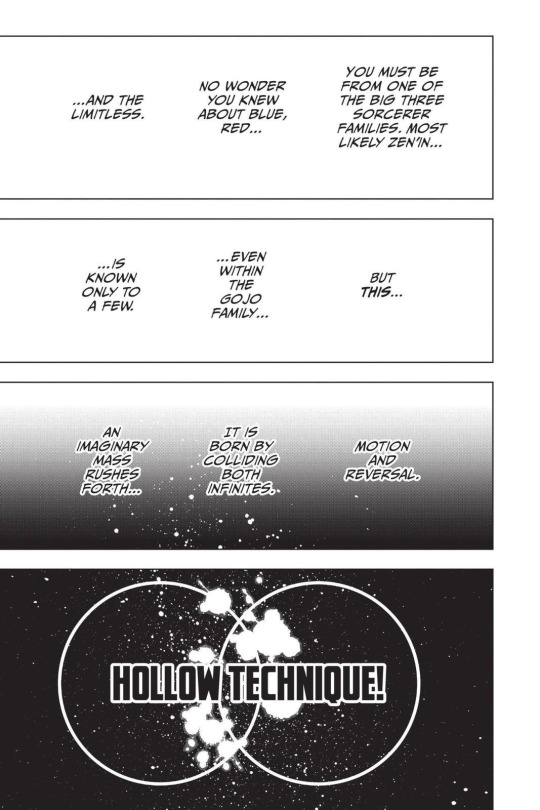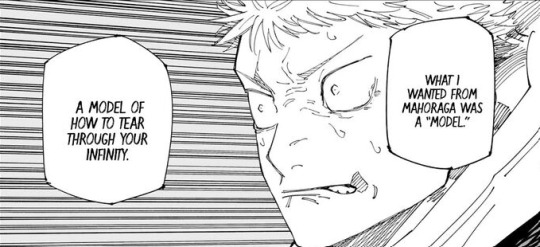#A love which bisects the world. truly this is our sukugo kaisen
Explore tagged Tumblr posts
Text
"Ryuurin, Hanpatsu, Tsugai no Ryuusei" -- the incantation for World Slash, and an epitaph to Gojo Satoru.

In JJK, incantations are supposed to boost power of a particular technique. When Sukuna used World Slash to kill Gojo, he imposed a binding vow that allowed him a single-use activation without the requirement of a hand sign, in exchange for using incantations and directing the attack for all subsequent uses.
In this post I'll examine the specific phrases in Sukuna's incantation and argue that each phrase of the incantation corresponds to an application of Gojo's Limitless technique. Then I'll briefly relate this to the binding vow requirements to argue that Sukuna's promise to never forget Gojo for the rest of his life is one of the conditions of that binding vow.
1. "龍鱗"
First, "ryuurin" (dragon scales) describes the basic application of Limitless, a strong defensive barrier like the scales of a dragon. This one is the most obvious, hinted at by Sukuna's words at the beginning of the fight, telling Gojo he plans to "strip away his scales." More will be said about the dragon references, in the discussion of the third phrase.


Less relevant but still interesting - there’s also a Buddhist reference here, according to this forum post:
At surface, straight value, it is just the literal scales of a dragon. The word can also be used to mean "a large quantity of things". Ryurin is also a metaphor for the power/authority/influence of heroes and of the Heavenly People (the residents of the Japanese version of the Devaloka, where devas and gods reside. Just a heavenly realm, basically.) Lastly, Ryurin means a dangerous condition/situation or a dangerous thing. So. For Sukuna, its basically 'dangerous divine power/authority'.
2. "反発"
Next, "hanpatsu." Hanpatsu means recoil, which is the equal and opposing force of an action. This describes Purple, which is the rebounding damage created by the collision of Red and Blue. At first I thought hanpatsu described Red, because Red is a “repulsing” force. Except “recoil” is not the same thing as repulsion. Another possibility was that hanpatsu described the relationship between Red and Blue — Red as the “equal and opposite” of blue, and vice versa. But we know the two aren’t equal in power, and neither technique is accurately described as the “recoil” or rebounding force produced by the other.

3. "番いの流星"
Finally, "tsugai no ryuusei." A few things here. First, the wordplay and translation. Like ”Ryuurin”, this term references dragons. Here Ryuusei, meaning meteor or comet, is also pun on the word dragon, ryuu (which isn’t novel, see the Japanese word for Pokémon move Draco Meteor, et al.). So a plausible English translation could also be “Twin Dragon Meteors.” Second, how dragons are relevant to Sukuna’s mythology. In Hida, there is a temple Senkoji said to be founded by “Ryomen Sukuna … approximately 1,600 years ago. A central architectural feature of the temple it Dragon Ceiling, a portrait of two dragons painted by Kano Tansetsu on the ceiling of the main buliding. From the website,
According to temple legend, a general of the Sengoku period committed suicide there by seppuku, staining the floor with blood. For the repose of general’s soul, the floorboards were incorporated into the ceiling of the main temple. Some time later, Kano Tansetsu visited Senkoji and painted the dragons on the ceiling. At Senkoji, the objects of worship include not only the main temple and the priest’s quarters, but also the entire temple complex.
According to this Reddit post, the temple’s founding tale describes how Sukuna fought off a dragon god living in the mountain and built a shrine in its place. So — from the fact that dragons are the mythological enemy of the figure Ryomen Sukuna, we may infer that the words of the incantation refer to an enemy or target of the World Slash technique.
What could "twin meteors" refer to other than the related techniques of Limitless, the twin floating spheres Red and Blue?
Another potential connection to Red/Blue rooted in dragon mythology is the tide jewels — the tide-ebbing (a repelling force, like Red) kanju and tide-flowing (an attracting force, like Blue) manju, possessed by Ryuujin, the Sea King.
The final reason I think the incantation refers to Gojo’s technique is because of Sukuna’s explanation in 236 for World Slash — he describes the process of developing the technique as figuring out how to target Limitless with Dismantle. So it makes sense that the incantation to power World Slash operates by describing its target, not World Slash itself.

It also lends significance to the order of the incantation — first visualizing the most generalized application of Limitless (ryuurin), then passing through Purple (hanpatsu) to finally arrive at two separate applications, Red and Blue (tsugai no ryuusei) — a conceptual "bisection" of Limitless into two discrete components.
4. Binding Vows
Isn't this pretty romantic? But wait there's more. We know now after Chapter 255 that in exchange for unleashing the World Slash that killed Gojo without using the hand sign, Sukuna now has to recite the incantation every time (+using the hand signs and directing the attack with his palm) he uses World Slash.
Assuming what I've previously argued is true (the incantation describes Gojo's Limitless), this gives Sukuna's last words to Gojo another layer of significance. When Sukuna tells Gojo he will never forget him, it's not just an expression or a promise, but a statement of the binding vow Sukuna has to make in order to land the killing blow. In other words, the cost of killing Gojo is having to remember him forever, to integrate him into Sukuna's own technique through a verbal invocation that must be made every single time Sukuna uses the world bisecting slash. Yeah, that's pretty romantic.

#ryomen sukuna#gojo satoru#sukugo#A love which bisects the world. truly this is our sukugo kaisen#jjk meta#jjk#jujutsu kaisen#jujutsu kaisen meta#idk what else to tag this as#binding vows#?#jjk analysis#pardon some of the writing here this was originally a text msg I sent to a friend#it’s a very wordy outline pretending to be an essay
354 notes
·
View notes